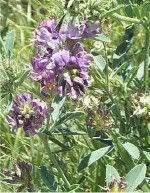

Alfalfa (Medicago sativa)
Folk Names: Al-fasfasah (Arabic - Best Fodder), Buffalo Herb, Chilean Clover, Lucerne, Purple Medic
Description: Alfalfa is a member of pea family. Originally from Spain, Italy, and France, it was naturalized to the Americas around 1850 to 1860. It now grows from Maine to Virginia and westward to the Pacific coast in the US, but it will grow practically anywhere. Alfalfa is a perennial. Its two hairy stems are erect or prostrate and smooth, growing from one to three feet. It has an elongated, deep-growing taproot. The leaves are dark green, pinnately trifoliate with oblong or linear-oblong leaflets. These are toothed toward the tips. The flowers grow in racemes from May to October. The calyx is five-toothed, and the stamen features nine united with one free. They are small and pea-like, ranging from blue or purple flowers to yellow. The seedpods twist in a spiral.
Effects: gentle
Planet: Venus
Element: Earth
Associated Deities:
Traditions:
Alfalfa is one of the first known herbs. Discovered by the Arabs, they called it the “Father of all Foods.”
Magic:
Keep alfalfa in your home for protection against poverty and hunger. Place it in a small jar in your pantry or cupboard or in a packet for this purpose. Use in any money spells you may wish to perform. It may be burnt and the ashes scattered or carried with you for prosperity.
Alfalfa may also be carried for the courage and strength of the buffalo, to dispel melancholy, and to secure love within the family.
Known Combinations:
None noted
Medical Indications: Parts Used : leaves, flowers, petals, sprouts (use in fresh, raw form - especially sprouts- to receive vitamins and mineral content)
Those with lupus erythematosus may wish to avoid this herb as it can cause a flare up. Eating too much alfalfa may cause photosensitivity in some people.
The depth and spread of alfalfa root allows the plant to absorb nutrients from as far as 125 feet below the earth. Its organic salts are among the richest known. Alfalfa is abundant in vitamins Alpha-carotene, beta-carotene, B-complex, C, D, E, and K, as well as enzymes and amino acids and protein, chlorophyll, calcium, copper, iron, magnesium, phosphorus, potassium, sodium, sulfur, and zinc.
Alfalfa is used as an appetizer and tonic, to lower cholesterol, and as an anti-fungal agent. As a gentle diuretic/laxative, it is suitable for urinary tract infections. It alkalizes and detoxifies the body, eases inflammations, balances hormones, and promotes pituitary and gland function. Due to its vitamin and mineral content, alfalfa is good for anemia and bleeding related disorders, bone and joint disorders, colon and digestive disorders, skin disorders, and convalescence from illness. It may be made into a tea to improve the appetite, relieve urinary and bowel problems, peptic ulcers, and acid stomach.
Nutrition:
Use the young leaves or sprouts in salads. The leaves may be cooked or made into a tea.
Mercantile Uses:
Alfalfa is cultivated in Peru and Persia. Growing in some of the most inhospitable regions, it will yield two harvests per year and is a sought after fodder crop for horses and cattle. It is used to increase milk in cows, to fatten the animals, to make chickens lay more, and keep the livestock healthy. The only drawback in growing this herb is that it takes free to four years for it to attain its full growth as the root needs time to penetrate.